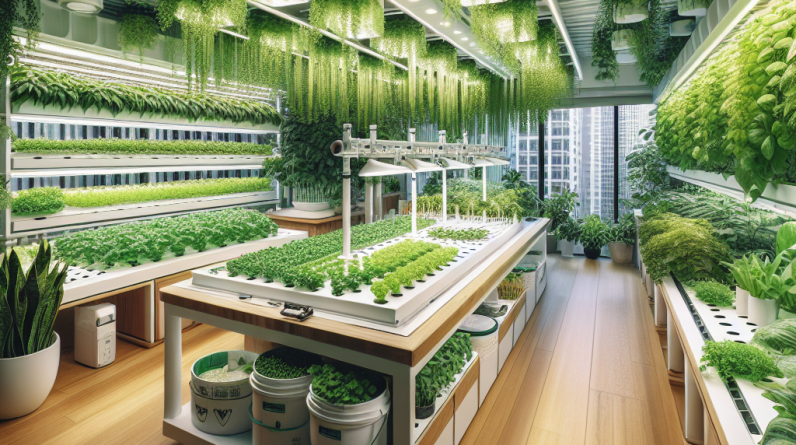
Understanding Hydroponics
What is Hydroponics?
So, let’s kick things off with the basics. Hydroponics is this super cool method of growing plants without soil. Yup, you heard that right; it’s like plants on a diet! They thrive in nutrient-rich water, which gives them all the good stuff they need to grow big and strong. This is a game-changer for urban dwellers like me who may lack access to traditional gardening space.
What’s fascinating is how it mimics nature. In a hydroponic system, the water carries nutrients directly to the plants’ roots. This means they can absorb what they need at lightning speed. It’s like giving your plants a smoothie instead of a salad! Trust me, once you dive into it, you’ll realize there’s a whole world of possibilities.
Plus, hydroponics can actually help save water, which is essential these days. It uses way less water than traditional gardening since you’re not dealing with any soil runoff. Pretty impressive, right? More plants, less water—what’s not to love?
Benefits of Hydroponic Systems
Environmental Impact
Now, let’s talk benefits because who doesn’t love those? One of the biggest perks of hydroponics is its environmental friendliness. By growing plants without soil, we reduce the need for pesticides and fertilizers that can harm our planet. It’s a way of gardening that honors Mother Earth!
Moreover, I’ve found that hydroponic systems are often located in urban areas, which means we can grow food right where we consume it. This reduces transportation emissions and promotes local economies. Nothing beats fresh veggies from the neighborhood, right?
And get this, hydroponics can also help mitigate food deserts. With more people growing their own food in these controlled environments, we can bring fresh produce to communities that traditionally might not have that access. It’s a win-win!
Setting Up Your Hydroponic Garden
Choosing the Right System
When I was setting up my own hydroponic garden, I realized one of the first steps was picking the right hydroponic system. There are several types out there, like Deep Water Culture, Nutrient Film Technique, and Ebb and Flow systems. Each one has its benefits, so it’s all about finding what works for you!
I ended up going with a vertical garden system because it’s perfect for my small apartment. Plus, who doesn’t love the aesthetics of lush greenery climbing up walls? It’s all about using the space you have, and that vertical setup can fit just about anywhere.
Before you dive in, do your research. Take some time to learn about the different systems and the plants you want to grow. It’s smart to know what you’re getting into so you can set yourself up for success right from the start.
What to Grow in Your Hydroponic System
Choosing Your Plants
Okay, once you’ve got your setup, the next exciting thing is picking what to grow! In my experience, leafy greens like lettuce and kale are fantastic starters. They grow quickly and don’t need as many nutrients compared to fruiting plants. Perfect for beginners!
If you’re looking to challenge yourself a bit, try growing herbs. Basil, mint, and cilantro are great choices and can add fresh flavors to your meals. Plus, there’s something so satisfying about snipping off your fresh herbs while cooking.
And for those of you eager to go big—the sky’s the limit! Hydroponics can support larger fruits like tomatoes, cucumbers, and peppers, too. Just remember, some of these will require more attention and care, so focus on your skill level as you make your selections.
Sustaining Your Hydroponic Garden
Ongoing Maintenance
Now, let’s chat about maintenance. Just because you aren’t dealing with soil doesn’t mean you’re off the hook! Regular maintenance is crucial for keeping your hydroponic system healthy and thriving. You’ll need to monitor pH levels, nutrient concentrations, and water quality.
I found that establishing a routine is key. Every week, I check my nutrient solution and pH levels to make sure everything’s in check. It’s a bit like checking in on a fitness plan—your plants need the right balance to perform their best!
Also, keep an eye out for any pests. Even without soil, bugs can find their way to your plants. A quick inspection now and then will save you a headache later! It all adds up to create a vibrant, sustainable growing environment.
Frequently Asked Questions
What is the cost of setting up a hydroponic system?
The initial investment can vary depending on the system you choose, but there are budget-friendly kits available. I recommend starting small to gauge what you enjoy and can manage.
Can I grow food all year round using hydroponics?
Absolutely! One of the coolest things about hydroponics is that you can grow fresh produce irrespective of the season. As long as you have a controlled environment, those greens can thrive!
Is hydroponics more sustainable than traditional farming?
Yes! Hydroponics typically uses less land and water and can reduce the carbon footprint associated with food transportation. It’s a sustainable way to grow right in your backyard or balcony!
What are the best plants for beginners in hydroponics?
Leafy greens like lettuce and herbs like basil and mint are fantastic for newbies. They grow quickly and are pretty forgiving, making the learning curve much smoother!
Are there any health risks associated with hydroponically grown food?
When managed correctly, hydroponics can produce very safe and healthy food. Just take care of your system—keep it clean and monitor for pests or disease as you would with traditional gardening.







